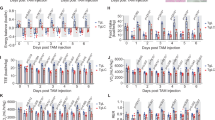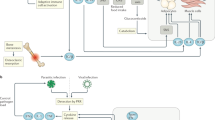Abstract
Early and severe loss of body weight associated with pronounced tissue changes developed in rats transplanted with a fast-growing ascites hepatoma (Yoshida AH-130). The protein content showed an early and marked fall in the skeletal muscle, while in the liver it transiently increased 4 days after implantation then declined to values lower than in control animals. Protein loss in gastrocnemius muscle and liver resulted mainly from enhancement of protein catabolism (Tessitore L. et al., Biochem. J., 241: 153-158, 1987). In contrast to the tumour-bearing rats, in the pair-fed animals the initial body weight was maintained, while the protein mass decreased sharply in the liver and moderately in the gastrocnemius muscle. In host animals total plasma protein decreased during the period of tumour growth, while both triglycerides and total cholesterol markedly increased. Glucose remained unchanged even when overt cachexia had developed. The total free amino acid concentration in the plasma of tumour-bearing rats decreased slightly by day 4 and returned to values close to those of controls in the late stages of tumour growth. By contrast, in the pair-fed controls the plasma levels of triglycerides and particularly of total free amino acids and glucose decreased over the whole experimental period, whereas total protein and cholesterol were unchanged. Marked perturbations in the hormonal homeostasis developed early after tumour transplantation. The plasma levels of glucagon, corticosterone and catecholamines rose sharply, while those of insulin and thyroid hormones decreased. Furthermore, high plasma concentrations of prostaglandin E2 (PGE2) and tumour necrosis factor (TNF) were observed over the whole experimental period. IL-1-like activity, TNF and PGE2 were released in vitro from AH-130 cells. These data suggest that the systemic effects of AH-130 tumour on the host rat reflected the interplay of a complex network of factors, including classical hormones and cytokines, all of which likely concur in enhancing tissue protein catabolism.
This is a preview of subscription content, access via your institution
Access options
Subscribe to this journal
Receive 24 print issues and online access
$259.00 per year
only $10.79 per issue
Buy this article
- Purchase on Springer Link
- Instant access to full article PDF
Prices may be subject to local taxes which are calculated during checkout
Similar content being viewed by others
Author information
Authors and Affiliations
Rights and permissions
About this article
Cite this article
Tessitore, L., Costelli, P. & Baccino, F. Humoral mediation for cachexia in tumour-bearing rats. Br J Cancer 67, 15–23 (1993). https://doi.org/10.1038/bjc.1993.4
Issue Date:
DOI: https://doi.org/10.1038/bjc.1993.4
This article is cited by
-
Insulin secretion decline in Walker-256 tumor-bearing rats is early, follows the course of cachexia, and is not improved by lixisenatide
Naunyn-Schmiedeberg's Archives of Pharmacology (2021)
-
Advances in the diagnosis and treatment of patients with cancer cachexia
Oncology and Translational Medicine (2018)
-
Effects of celecoxib and ibuprofen on metabolic disorders induced by Walker-256 tumor in rats
Molecular and Cellular Biochemistry (2015)
-
Decreased response to cAMP in the glucose and glycogen catabolism in perfused livers of Walker-256 tumor-bearing rats
Molecular and Cellular Biochemistry (2012)
-
l‐carnitine and cancer cachexia: Clinical and experimental aspects
Journal of Cachexia, Sarcopenia and Muscle (2011)



